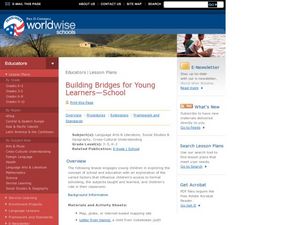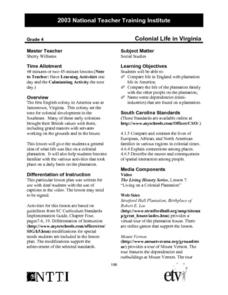Curated OER
Multicultural Fairy Tales
Third graders explore the elements of a story using fairy tales from all over the world. They compare and contrast story elements, key ideas and concepts found in a variety of texts from around the world.
Curated OER
Let's Celebrate Hanukkah!
Students identify and analyze various multicultural celebrations. They list their prior knowledge of the Jewish Holiday known as Hanukkah and listen to various books about the celebration. Students also compare and contrast Hanukkah to...
Curated OER
Ways we are Alike/ Ways we are Different
Students complete a chart comparing and contrasting African villages with their own communities. The lesson focuses on the Mbuti and Fulani people. They explore their style of living, their traditions and everyday life in these villages.
Curated OER
Different! Diverse! Dynamic! What Do Stories Share?
Students compare and contrast the stories, "Leo, the Late Bloomer," and "Thank You, Mr. Falker." They develop a Venn diagram, and write and illustrate the central theme of the stories.
Curated OER
Jazz and Math: Rhythmic Innovations
High schoolers compare and contrast the rhythms of marches and jazz. They watch an excerpt about Buddy Bolden from the PBS Ken Burns Jazz documentary, compare/contrast march and jazz rhythms, complete a worksheet, and notate and perform...
Curated OER
Ice Cream Toppings
Students explore the five senses. In this senses lesson, students use their senses to top their ice cream. Students compare and contrast the different toppings and write their observations, using descriptive words, in a notebook.
Curated OER
Living in Kansas Today
Students compare and contrast urban and rural communities. In this geography skills lesson, students discover the attributes of the settings and respond to questions about cities and farms.
Curated OER
Patterns & Balance
Students compare and contrast the difference in the two sets of images and discuss the visual interest in the first set and the different visual interest created in the second set of prints.
Curated OER
Impressionism and Beyond
Young scholars view a video, and they are reminded that Impressionism was an artistic movement that begin in Pairs in the 1800s. They are asked to think about the paintings featured in the video and describe the typical style of these...
Curated OER
Studying Fossils
Students compare and contrast key skeletal differences between chimpanzees and humans: brain size, teeth, hand and thumb, trunk, pelvis, lower limb, foot and big toe. They then sort and group a set of mixed "fossil bones" of chimpanzee...
Curated OER
EARLY CIVILIZATIONS
Students compare and contrast the monuments of four ancient cultures and draw conclusions about the origins, construction, and purposes of these structures.
Curated OER
Vanishing Verbs
Students analyze recent media trends, and develop critical thinking skills by summarizing main ideas, extracting details, formulating opinions, drawing inferences, and comparing and contrasting attitudes. They also practice paraphrasing...
Curated OER
Parts of a Solar Panel-Part I
Students examine electrical contacts, solar cells, and rechargeable batteries and compare and contrast the characteristics of a solar cell to a rechargeable battery in a hands-on activity. Students complete a worksheet as they...
Curated OER
Reading the Play
Middle schoolers read the play "Julius Caesar" by William Shakespeare. In groups, they identify the instances of similes, metaphors and personification. They use the Internet to compare and contrast the events in the play with historical...
Curated OER
George Washington: The President Without Precedent
Students explore time period and events surrounding George Washington's inauguration, demonstrate how Washington set precedent for each action he took as American Republic's new president, and compare and contrast traditions and events...
Curated OER
Crystal Painting
Young scholars investigate crystalline solids. In this crystals lesson, students observe samples of natural crystals and compare and contrast each. They draw pictures with crayons and then paint over their picture using crystalline...
Curated OER
Fighter Pilots of World War II
Young scholars explore the types of airplanes that were used in World War II. In this World History lesson, students write a research paper that compares and contrasts three types of American airplanes and three types of foreign...
Curated OER
How Women Got the Vote: The Story of Carrie Lane Chapman Catt
Students participate in a simulation and compare and contrast the arguments for and against womens' right to vote. In this civil rights lesson, students simulate disenfranchisement of women by allowing only half of the class to vote on a...
Curated OER
Building Bridges for Young Learners- School
Young scholars examine the purpose of education. In this schooling lesson, students read a letter from a child in Uzbekistan. Young scholars compare and contrast their schooling to children around the world.
Curated OER
Polygons, Parallelograms, Quadrilaterals- Oh My!!!
Students demonstrate their comprehension of shapes and their properties. They work in small groups. Students review the following terms: property, polygon, quadrilateral, and parallelogram. They read Shape Up! Fun With Triangles and...
Curated OER
Colonial Life in Virginia
Fourth graders compare and contrast life in England with plantation life in America. They study the dependencies or mini-industries that could be found on plantations.
Curated OER
THEMATIC ESSAY
Students Compare and contrast the beliefs and methodology of three leaders of the Civil Rights movement. Using specific examples, discuss how these leaders were either successful or unsuccessful in attaining their goals.
Curated OER
How Tragic!
Tenth graders read and study, in-depth, a specific classical tragedy, in this case, Oedipus. They explore strategies from making meaning out of or interpreting texts, as well as strategies for determining how authors create meaning in...
Curated OER
Cinderella Project
Learners compare and contrast the stories of "Cinderella" and "Little Gold Star." Students discuss the magic helper in both stories. Learners become the magic helper by bestowing random acts of kindness on others. Students receive stars...

























